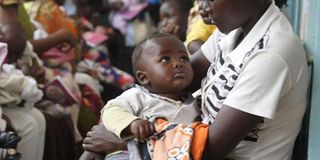Insecurity and women dying from childbirth define northern Kenya

Mother and child at a health centre in Kisumu. Women in northern Kenya suffer high mortality rates. FILE PHOTO | TOM OTIENO |
What you need to know:
- In North Eastern Kenya, out of every 100,000 births, about 1,200 to 1,300 women die, or 12 women out of every 100.
- When a mother dies while delivering a baby, the child’s chances of survival are diminished.
- Generally, women die as a result of simple and preventable complications such as haemorrhaging, obstructed labour, sepsis, and high blood pressure.
- A recent report by the Controller of Budget shows that county governments spent Sh1.07 billion on domestic and foreign travel.
Attention is currently focused on North Eastern Province following the upsurge in insecurity.
Hopefully, the measures currently being put in place will ensure that the residents of this region will be able to go about their day-to-day activities in peace, without the fear of attack.
However, focus must go beyond security concerns to other equally, if not more, serious threats to the very survival of the region.
One such threat is women dying from maternity or childbirth-related complications.
It is telling that the number of deaths from maternity is more than those caused by terrorism and other forms of insecurity.
In North Eastern Kenya, out of every 100,000 births, about 1,200 to 1,300 women die.
This translates to losing 12 women out of every 100.
STATISTICS AND REAL LIFE
At the national level, Kenya loses 488 mothers out of every 100,000 births. In real numbers, about 7,700 women die in Kenya every year from pregnancy and childbirth-related complications.
Unfortunately, statistics are hard, cold figures often bandied about by experts in global or national reports, seminars, or workshops, but are difficult to relate to in the day-to-day reality of life.
We are talking about 7,700 women, mostly in the prime age of 18 to 45 years, dying each year as they try to give life to another human being.
This translates to approximately 21 women dying daily.
SURVIVAL UNLIKELY
When a mother dies while delivering a baby, the child’s chances of survival are diminished.
The child will not only miss breast milk (proven to increase the chances of infant survival by 40 per cent) but will also lack the love, warmth, care, and protection of a mother.
Chances are that such a child will die before reaching the age of five.
The death of a mother also destroys families, takes children out of school, and lowers household and community economic productivity, thus posing a serious challenge to broader social economic development.
The national average obscures the crisis of maternal mortality in North Eastern Kenya (NEK), which compares only with war-torn countries such as Somalia and Afghanistan. One in 12 women in NEK is at risk of dying compared to one in 46,600 in Ireland, for example.
CUMULATIVE FAILURE
How did things get so bad for North Eastern?
Cumulative failure to invest in the health system for the region over the years, poverty, illiteracy, poor roads, lack of access to essential services such as safe drinking water and electricity, all contribute to this sad state of affairs.
Generally, women die as a result of simple and preventable complications such as haemorrhaging, obstructed labour, sepsis, and high blood pressure.
These complications are easily managed when a woman delivers in a health facility and with the help of a trained health worker.
CURRENT LAWS FAILING
To its credit, the government has abolished maternity fees and with support from partners, has put in place a number of laws, strategies, and policies to improve maternal and child health.
These include the National Reproductive Health Policy of 2007, the Ministry of Health Kenya National Health Strategic Plan, and the National Maternal Neonatal Health Road Map 2010, with the goal of accelerating the reduction of maternal and newborn mortalities.
However, these laws, strategies, and policies, as designed and currently being enforced, have failed to reduce maternal mortality in NEK and other arid and semi-arid regions.
The government and partners such as Unicef have invested in strengthening health systems in NEK by increasing the number of women who deliver with the assistance of skilled health workers from eight per cent in 2003 to 47 per cent in 2009. However, this is still way below the national target of 90 per cent.
FOREIGN TRAVEL
The problem of maternal mortality requires an efficient and effective health system.
A recent report by the Controller of Budget shows that county governments spent Sh1.07 billion on domestic and foreign travel.
That Wajir is one of them, while women bleed to death and infants die due to septicaemia, is shocking.
The people of NEK and other arid and semi-arid regions must address the problem by engaging local leaders, and particularly the politicians, to prioritise maternal and child health.
The writer is Director, Mount Kenya University, Garissa Campus. ([email protected])




